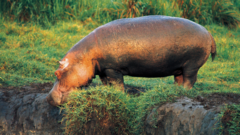At least 50 hippos and other large animals have been attributed to an anthrax poisoning outbreak in Virunga National Park, as confirmed by park officials. The grim discovery began last week, with images released by the national park showing deceased animals floating in the Ishasha River. Although the source of the outbreak remains unclear, tests have verified the presence of anthrax in the area. Emmanuel de Merode, park director, emphasized the challenges faced while attempting to recover and properly bury the animals, noting the absence of excavators and logistical difficulties, but he indicated attempts were underway to limit the spread of the disease using caustic soda.
The Ishasha River feeds into Lake Edward, where even more deceased wildlife has been reported. Anthrax, which stems from the bacterium Bacillus anthracis, poses a deadly risk but typically does not spread rapidly; it often survives in dormant spore form in soil for extended periods before infecting animals through wounds or inhalation. The Congolese Institute for the Conservation of Nature has issued warnings to local residents, advising them to stay away from wildlife and to boil all water from nearby sources before consumption.
Covering an area of 7,800 square kilometers, Virunga National Park is celebrated for its biodiversity but also notorious for the dangers posed by armed conflict and militant groups seeking control over the region's natural resources. The park, a key attraction for tourists, has seen many of its rangers pay the ultimate price in their efforts to protect its wildlife. In recent years, concerted efforts have been made to revive the hippo population, which plummeted from over 20,000 to just a few hundred due to rampant poaching and warfare.

















